In the fast-moving world of e-commerce, few innovations have had as clear an impact as Augmented Reality (AR) and Virtual Reality (VR). What started as experimental features like virtual try-ons or “see it in your space” tools has quickly become a powerful driver of business performance. The numbers speak for themselves: AR/VR is not just enhancing shopping experiences; it’s directly boosting conversions and reducing costly returns.
Conversions Skyrocket with AR/VR
One of the biggest wins for retailers adopting AR and VR is the uplift in conversion rates. Products that include AR experiences often see conversion rates jump by as much as 94% compared to products without them. In some categories, especially furniture, fashion, and beauty, AR can even boost conversions by up to 200%.
Why such dramatic growth? It comes down to confidence. When shoppers can preview furniture in their living room, test how glasses look on their face, or experiment with a lipstick shade, they move past hesitation. The uncertainty that usually stalls online purchases fades away, replaced by a sense of trust and excitement. AR/VR turns browsing into interaction and interaction drives sales.
AR/VR’s Role in Reducing Returns
Returns are one of the biggest pain points for e-commerce businesses, cutting into profits and damaging customer relationships. Here too, AR/VR is proving to be a game changer.
Retailers using AR tools report a 22–40% reduction in return rates. This is because customers know exactly what they’re buying before it arrives. A sofa fits the space. A sneaker matches the outfit. A lipstick looks right with the skin tone. When expectations align with reality, disappointments and returns fall dramatically.
This isn’t just good for businesses; it’s good for customers too. Fewer returns mean less frustration, less waiting, and a smoother shopping experience overall.
Beyond Sales: Engagement & Insights
The benefits of AR and VR don’t stop at conversions and returns. Shoppers spend 2–5x longer engaging with products that feature interactive experiences, whether through AR filters, 3D product views, or VR showrooms. Every second spent trying and exploring builds a stronger connection between brand and buyer.
Even more valuable, these interactions generate rich behavioral data. Retailers can see what styles customers try on most, which products they explore in AR, and where they hesitate turning AR into not only a sales tool but also a data goldmine for better decision-making.
The Bottom Line
A growing body of research reveals that AR and VR are not only improving customer engagement but also significantly boosting conversion rates and reducing costly product returns.
One standout statistic comes from a Deloitte Digital study, which found that AR product experiences can increase conversion rates by up to 94%. Similarly, Shopify reports that products with AR content saw a 94% higher conversion rate compared to those without. These numbers reflect a simple truth: when shoppers can “try before they buy” virtually, their confidence in purchasing goes up dramatically. For online retailers, this translates into fewer abandoned carts and higher revenue per visitor.
One of the biggest headaches in e-commerce is Returns, which are also being directly impacted. A study by Snap Inc. found that AR reduces the likelihood of returns by nearly 25% because customers have a much clearer idea of how products will look or fit in their real-world environment. Whether it’s testing how a sofa fits in a living room or how a pair of sneakers looks on your feet, AR provides a more accurate expectation of the product. The result? Customers are happier with their purchases, and retailers save money on return logistics.
Beyond these immediate financial benefits, AR and VR experiences also build trust and loyalty. Customers feel empowered when they can interact with a product digitally, leading to stronger brand affinity. For example, beauty brands offering AR-powered “virtual try-on” tools report not only higher sales but also stronger engagement, as customers spend more time exploring products online.
Another major shift is occurring in industries such as furniture, home décor, and fashion, where product visualization is crucial. IKEA’s AR app allows shoppers to place furniture virtually in their homes, drastically improving decision-making. Similarly, eyewear brands like Warby Parker have pioneered AR-powered try-ons that mimic the in-store experience. These immersive experiences are now setting the standard for customer expectations.
The ripple effect is also visible in B2B e-commerce. Businesses investing in AR/VR product demos are closing deals faster because clients can visualize complex machinery, layouts, or prototypes without the need for physical samples. In a space where accuracy and detail are everything, AR is proving to be a game-changer.
As AR and VR continue to evolve, they are becoming less of a novelty and more of a necessity in online shopping. With statistics highlighting their ability to increase conversions, cut down returns, and enhance customer satisfaction, the future of e-commerce is being redefined by immersive technology. For retailers, the message is clear: adopting AR and VR is no longer about standing out — it’s about staying competitive.
AR and VR are no longer futuristic add-ons in e-commerce they’re measurable business drivers. By increasing conversions, cutting returns, and boosting engagement, they’re solving two of the industry’s toughest challenges while delighting customers in the process.
As adoption grows, the competitive edge will belong to brands that use AR/VR not just as a novelty, but as a seamless, reliable part of the shopping journey. For shoppers, it means more fun, more trust, and more confidence. For retailers, it means healthier margins, fewer headaches, and stronger loyalty.
The future of online shopping is clear: it’s immersive, it’s interactive, and it’s powered by AR and VR.


